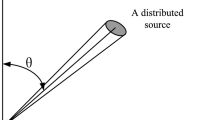Abstract
In the field of array signal processing, direction of arrival (DOA) estimation is a prime area of research. DOA estimation and adaptive beamforming (ABF) are the main issues in smart antennas, which dynamically find the direction of desired and interfering users and finds the optimum weights for beamforming. There are numerous spectral and eigen structure algorithms for estimating the direction of narrow band sources. However, in a complex multipath channel environment, received signals from different directions are fully or partially correlated, which prevents the applications of high resolution techniques to estimate the direction of incoming signals. Maximum likelihood (ML) is an efficient technique for DOA estimation in a low signal to noise ratio (SNR) and coherent channel environment. In this paper, we use particle swarm optimization (PSO) for estimating ML solution by optimizing complex non linear multimodal function over a high dimensional space in linear arrays. PSO-ML estimator has been compared with conventional DOA estimation techniques in uncorrelated, partially correlated and coherent channel environment. The performance of PSO-ML estimator and conventional algorithms are analyzed in varying partially correlated channel environment. The simulation results demonstrate that PSO based estimator gives superior statistical performance.











Similar content being viewed by others
References
Schmidt, R. O. (1986). Multiple emitter location and signal parameter estimation. IEEE Transactions on Antenna Propagation, 34(3), 276–280.
Capon, J. (1969). High-resolution frequency-wavenumber spectrum analysis. Proceedings of IEEE, 57(8), 1408–1414.
Roy, R., & Kailath, T. (1989). ESPRIT-estimation of signal parameters via rotational invariance techniques. IEEE Transactions on Signal Processing, 37(7), 984–995.
Godara, L. C. (1997). Application of antenna arrays to mobile communications, part II: Beam-forming and direction-of-arrival considerations. Proceedings of IEEE, 85, 1195–1245.
Sharma, A., & Mathur, S. (2016). Performance analysis of adaptive array signal processing algorithms. IETE Technical Review, 33(5), 472–491.
Shan, T. J., Wax, M., & Kailath, T. (1985). On spatial smoothing for direction-of-arrival estimation of coherent signals. IEEE Transactions on Acoustics, Speech, and Signal Processing, 33(4), 806–811.
Pillai, S. U., & Kwon, B. H. (1989). Forward/backward spatial smoothing techniques for coherent signal identification. IEEE Transactions on Acoustics, Speech, and Signal Processing, 7(1), 8–15.
Sarkar, T. K., & Pereira, O. (1995). Using the matrix pencil method to estimate the parameters of a sum of complex exponentials. IEEE Antennas and Propagation Magazine, 37(1), 48–55.
Yilmazer, N., Koh, J., & Sarkar, T. K. (2006). Utilization of a unitary transformation for efficient computation in the matrix pencil method to find the direction of arrival. IEEE Transactions on Antennas and Propagation, 54(1), 175–181.
Gonnouni, A. E., Ramon, M. M., Alvarez, J. L. R., Valls, G. C., Vidal, A. R. F., & Christodoulou, C. G. (2012). A support vector machine MUSIC algorithm. IEEE Transactions on Antennas and Propagation, 60(10), 4901–4910.
Zhang, Y. F., & Ye, Z. F. (2008). Efficient method of DOA estimation for uncorrelated and coherent signals. IEEE Antennas Wireless Propagation Letters, 7, 799–802.
Stoica, P., & Sharman, K. C. (1990). Maximum likelihood methods for direction-of-arrival estimation. IEEE Transactions on Acoustics, Speech Signal Processing, 38, 1132–1143.
Ziskind, I., & Wax, M. (1988). Maximum likelihood localization of multiple sources by alternating projection. IEEE Transactions on Acoustics, Speech, Signal Processing, 36(10), 1553–1560.
Sharman, K. (1988). Maximum likeliood estimation by simulated annealing (pp. 2741–2744). Proc.: ICASSP.
Stoica, P., & Gershman, A. B. (1999). Maximum-likelihood DOA estimation by data-supported grid search. IEEE Signal Processing Letters, 6, 273–275.
Holland, J. H. (1975). Adaptation in natural and artificial systems. Ann Arbor, MI: The University of Michigan Press.
Li, M., & Lu, Y. (2007). A refined genetic algorithm for accurate and reliable DOA estimation with a sensor array. Wireless Personal Communications, 43(2), 533–547.
Kennedy, J., & Eberhart, R. C. (1995). Particle swarm optimization. Proceedings of IEEE International Conference on Neural Networks, 4, 1942–1948.
Gies, D., & Samii, Y. R. (2003). Particle swarm optimization for reconfigurable phased-differentiated array design. Microwave and Optical Technology Letters, 38, 168–175.
Khodier, M. M., & Christodoulou, C. G. (2005). Linear array geometry synthesis with minimum side lobe level and null control using particle swarm optimization. IEEE Transaction on Antennas and Propagation, 53, 2674–2679.
Robinson, J., & Samii, Y. R. (2004). Particle swarm optimization in electromagnetics. IEEE Transaction on Antennas and Propagation, 52, 397–407.
Ciuprina, G., Ioan, D., & Munteanu, I. (2004). Use of intelligent-particle swarm optimization in electromagnetics. IEEE Transaction on Magnetics, 38, 1037–1040.
Messerschmidt, L., & Engelbrecht, A. P. (2004). Learning to play games using a PSO-based competitive learning approach. IEEE Transactions on Evolutionary Computation, 8, 280–288.
Chen, Y., Wang, H., & Su, J. (2006). Particle swarm optimization for image noise cancellation. In Proceedings of the first international conference on innovative computing, information and control (pp. 587–590). Washington DC: IEEE Computer Society.
Li, M., & Lu, Y. (2008). Maximum likelihood DOA estimation in unknown coloured noise fields. IEEE Transaction on Aerospace and Electronics Systems, 44(3), 1942–1948.
Author information
Authors and Affiliations
Corresponding author
Rights and permissions
About this article
Cite this article
Sharma, A., Mathur, S. Comparative Analysis of ML-PSO DOA Estimation with Conventional Techniques in Varied Multipath Channel Environment. Wireless Pers Commun 100, 803–817 (2018). https://doi.org/10.1007/s11277-018-5350-0
Published:
Issue Date:
DOI: https://doi.org/10.1007/s11277-018-5350-0




